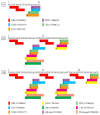XRCC5 VNTR, XRCC6 -61C>G, and XRCC7 6721G>T Gene Polymorphisms Associated with Male Infertility Risk: Evidences from Case-Control and In Silico Studies
- PMID: 28421111
- PMCID: PMC5379132
- DOI: 10.1155/2017/4795076
XRCC5 VNTR, XRCC6 -61C>G, and XRCC7 6721G>T Gene Polymorphisms Associated with Male Infertility Risk: Evidences from Case-Control and In Silico Studies
Abstract
We evaluate the association between genetic polymorphisms of XRCC5 VNTR, XRCC6 -61C>G, and XRCC7 6721G>T with male infertility susceptibility. A total of 392 men including 178 infertile males (102 idiopathic azoospermia and 76 severe oligozoospermia) and 214 healthy controls were recruited. XRCC6 -61C>G and XRCC7 6721G>T genotyping was performed by PCR-RFLP whereas XRCC5 VNTR was performed by PCR. The 2R allele and 2R allele carriers of XRCC5 VNTR polymorphism significantly decreased risk of male infertility. The mutant GG genotypes and carriers of the CG and GG genotypes of XRCC6 -61C>G showed increased risk for the male infertility. Furthermore, the G allele of the XRCC6 -61C>G was correlated with increased susceptibility to male infertility. Likewise, the T allele of the XRCC7 6721G>T polymorphism was associated with increased susceptibility to male infertility in azoospermia. In silico analysis predicted that the presence of tandem repeats in XRCC5 gene prompter can be sequence to bind to more nuclear factors. Also, rs2267437 (C>G) variant was located in a well-conserved region in XRCC6 promoter and this variation might lead to differential allelic expression. The XRCC7 6721G>T gene polymorphism occurred in an acceptor-splicing site, but this polymorphism has no severe modification on XRCC7 mRNA splicing. Our results indicate the association of XRCC5 VNTR, XRCC6 -61C>G, and XRCC7 6721G>T gene polymorphisms with male infertility in Iranian men.
Figures






Similar articles
-
Association Between Functional Polymorphisms of DNA Double-Strand Breaks in Repair Genes XRCC5, XRCC6 and XRCC7 with the Risk of Systemic Lupus Erythematosus in South East Iran.DNA Cell Biol. 2015 May;34(5):360-6. doi: 10.1089/dna.2014.2465. Epub 2015 Mar 10. DNA Cell Biol. 2015. PMID: 25756210
-
Sequence Variation in X-ray Cross Complimenting (XRCC4, XRCC5, XRCC6 and XRCC7) Genes and the Risk of Gastrointestinal Cancer in South-Western Maharashtra: A Hospital Based Case-Control Study.Asian Pac J Cancer Prev. 2025 May 1;26(5):1571-1579. doi: 10.31557/APJCP.2025.26.5.1571. Asian Pac J Cancer Prev. 2025. PMID: 40439368 Free PMC article.
-
Role of polymorphic XRCC6 (Ku70)/XRCC7 (DNA-PKcs) genes towards susceptibility and prognosis of lung cancer patients undergoing platinum based doublet chemotherapy.Mol Biol Rep. 2018 Jun;45(3):253-261. doi: 10.1007/s11033-018-4158-z. Epub 2018 Feb 3. Mol Biol Rep. 2018. PMID: 29397516
-
Radio-adaptive response and correlation of non-homologous end joining repair gene polymorphisms [XRRC5 (3R/2R/1R/0R), XRCC6(C/G) and XRCC7 (G/T)] in human peripheral blood mononuclear cells exposed to gamma radiation.Genes Environ. 2021 Mar 8;43(1):9. doi: 10.1186/s41021-021-00176-4. Genes Environ. 2021. PMID: 33685509 Free PMC article.
-
Association between XRCC5, 6 and 7 gene polymorphisms and the risk of breast cancer: a HuGE review and meta-analysis.Asian Pac J Cancer Prev. 2012;13(8):3637-43. doi: 10.7314/apjcp.2012.13.8.3637. Asian Pac J Cancer Prev. 2012. PMID: 23098447 Review.
Cited by
-
Genetic Landscape of Nonobstructive Azoospermia and New Perspectives for the Clinic.J Clin Med. 2020 Jan 21;9(2):300. doi: 10.3390/jcm9020300. J Clin Med. 2020. PMID: 31973052 Free PMC article. Review.
-
Genetic defects in human azoospermia.Basic Clin Androl. 2019 Apr 23;29:4. doi: 10.1186/s12610-019-0086-6. eCollection 2019. Basic Clin Androl. 2019. PMID: 31024732 Free PMC article.
-
Genetics and molecular biology of male infertility among Iranian population: an update.Am J Transl Res. 2021 Jun 15;13(6):5767-5785. eCollection 2021. Am J Transl Res. 2021. PMID: 34306325 Free PMC article. Review.
-
Genetic polymorphisms and haplotypes of the DJ-1 gene promoter associated with the susceptibility to male infertility.J Assist Reprod Genet. 2017 Dec;34(12):1673-1682. doi: 10.1007/s10815-017-1033-0. Epub 2017 Sep 20. J Assist Reprod Genet. 2017. PMID: 28932933 Free PMC article.
-
Interleukin-23 receptor (IL-23R) gene polymorphisms and haplotypes associated with the risk of preeclampsia: evidence from cross-sectional and in silico studies.J Assist Reprod Genet. 2019 Jul;36(7):1523-1536. doi: 10.1007/s10815-019-01479-w. Epub 2019 May 23. J Assist Reprod Genet. 2019. PMID: 31123953 Free PMC article.
References
LinkOut - more resources
Full Text Sources
Other Literature Sources
Research Materials
Miscellaneous

